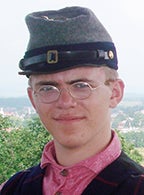Re-enacting history shows scars of battle
Published 10:14 am Friday, August 9, 2013
Column: Notes From Home, by Marshall Pederson
It is my fourth year as a Civil War re-enactor and I’m on my way to Gettysburg, the site of the most well-known battle of the war, and, during this 150th anniversary, the crown jewel of re-enactments. The original battle is the focus of volumes of books, articles, other writings and movies.
However, after 16 hours in an air-conditioned car with my cellphone and PSP to keep me entertained, I’m thinking more about the long march soldiers faced before arriving at this battlefield than anything else.
As we arrive, I open the car door to a blast of summer heat and notice a sea of white canvas. Tents are being set up in a pasture near a stand of trees, and thousands of soldiers in blue and gray are setting up camp on different areas of the fields. I am transported back 150 years. With more than 18,000 soldiers, artillery and cavalry, this is my largest re-enactment yet, and I enjoy the camaraderie of my fellow re-enactors.
The next day our company tours the battleground and museum. I am impressed that our uniforms are so historically accurate and how simple the needs were for soldiers at the time. Walking up Culp’s Hill and imagining how many souls were lost on this very ground, I feel chills run up my spine and a sickening pit open in my stomach.
Standing at Cemetery Ridge, site of Pickett’s Charge that resulted in a massacre of Southern soldiers, I remember how the local creek ran red with their blood for days after the battle. I feel my soul sadden and realize this is hallowed ground.
The third day features the battle of Seminary Ridge. My unit falls in with the Carolina Legion. We begin by drilling in the June heat, and then marching four miles to the battlefield. My feet are hurting; brogans are not comfortable shoes.
My gear, light at the beginning of our trek, soon weighs me down as if it’s filled with cannonballs. Cannons and muskets fire continually, and the sheer numbers of soldiers awes me. There is blinding smoke and my gun is hot, burning my hands. The long blue line never ends its attack on us. I “die” during this battle. Then we march back to camp; I’m hot, hungry and tired. We feast on potatoes, carrots and cool canned pears.
The fourth day is the Peach Orchard battle. Another long march through the woods, where we stand for an hour awaiting orders in the heat and humidity, in wool clothing that sticks to my body.
I remember how, at previous re-enactments I’ve attended, the South had won. During this battle, we are nearly surrounded by Union soldiers. I am “wounded” and lay on the ground, with guns firing over my head, men marching over the top of me, and more soldiers falling down beside me. I imagine how a soldier would have felt, fearing the worst: infection, amputation, lingering death, waiting for the field surgeon to remove him from the field.
Marching back to camp, my feet feel like two raw pieces of meat. I eat and go to bed early. I am physically and emotionally tired.
The last day features Pickett’s Charge. My feet are blistered, but we face yet another long march. Marching across the field, I am amazed by the massive numbers of Confederate soldiers beside and behind me. I know that more than half of these men will “die” today. I consider how Gen. George Pickett knew this was a suicide mission, but that soldiers were driven by their patriotic fervor. The Union army is a mile away, and I see how the Union artillery spreads across the line. Thousands of Union soldiers are lined up in front of us, protected by a stonewall.
All that went through my mind was “this is crazy” and “Oh my God, we are all going to die.” Outnumbered, our position makes us like fish in a barrel marching across the open field. I am “wounded” and my dad is “killed.” I glance out over the field and it seems like everyone is down “wounded or dead.” It is no wonder that Gen. Picket suffered a breakdown and never forgave Gen. Robert E. Lee for the orders of this day.
I reflect on what happened on the journey home, mortified that people could do this to one another. I think about how our country today is still divided in so many ways.
Marshall Pederson is a sophomore at NRHEG High School who lives in Geneva. He is a member of the Rochester Civil War Round Table. This essay earned a first place in 4-H judging at the Freeborn County Fair. David Behling returns next week.


